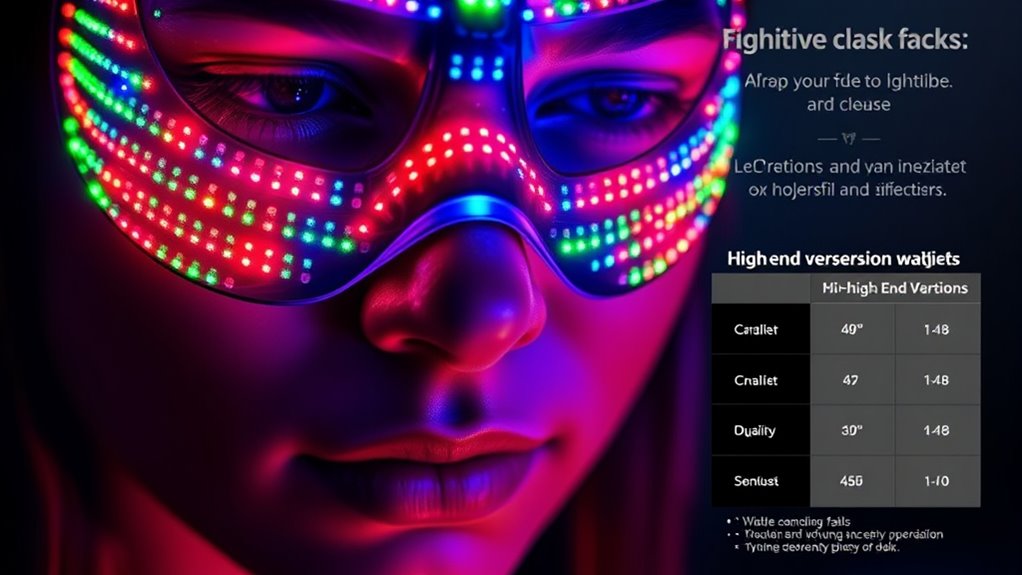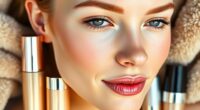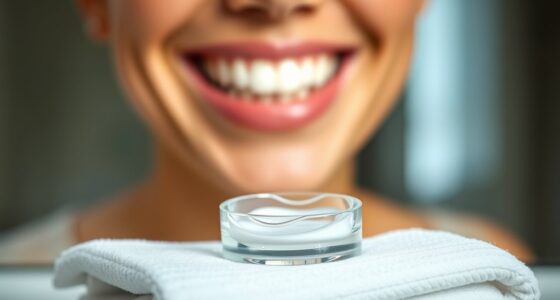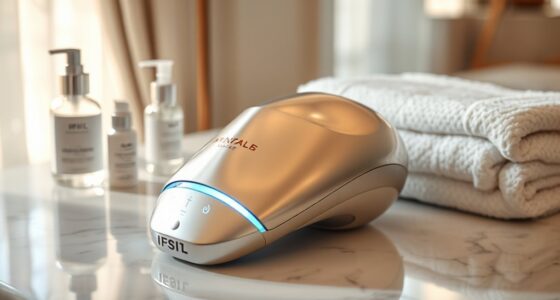Cheap LED masks often lack the precise wavelength calibration, sufficient light intensity, and safety certifications of $500 devices. As a result, they usually deliver less effective skin penetration, shorter-lasting results, and pose higher safety risks like burns or eye damage. Higher-quality masks use medical-grade materials, adjustable features, and verified clinical standards, making them more reliable. If you want to uncover more about how the differences really impact your skin health, keep exploring this comparison.
Key Takeaways
- Cheap LED masks often lack precise wavelength calibration, reducing their effectiveness compared to $500 devices with verified spectral accuracy.
- Budget masks typically use lower-quality materials and weaker light sources, leading to superficial skin penetration and less noticeable results.
- Certified higher-end masks ensure safety and consistent therapy through rigorous testing, unlike many inexpensive options that pose risks.
- Surprising studies show that inexpensive masks may deliver inconsistent wavelengths and insufficient power, undermining long-term skin benefits.
- Investing in a more expensive, certified device generally yields better penetration, durability, and overall treatment efficacy.
The Science Behind LED Light Therapy and Skin Benefits
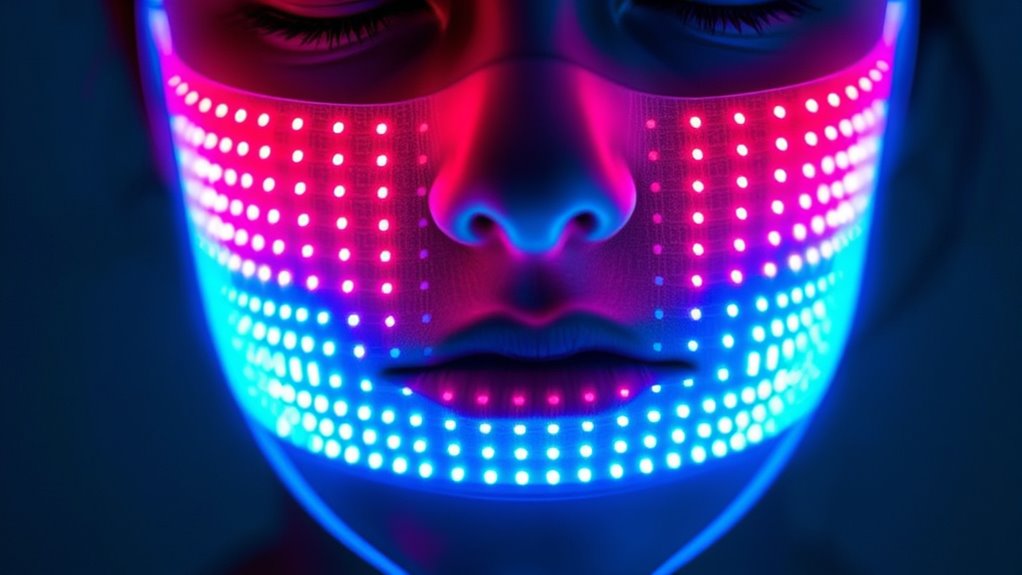
LED light therapy works by emitting specific wavelengths that skin cells absorb to trigger beneficial processes like collagen production and inflammation reduction. When you use LED light therapy, the light penetrates your skin at targeted wavelengths—such as red light (~630-680 nm)—to stimulate collagen production, resulting in firmer, more elastic skin. Longer wavelengths within the optical window (610-860 nm) penetrate deeper, promoting skin rejuvenation and tissue repair. Blue light (~415 nm) primarily targets surface bacteria linked to acne, but red light is more effective for anti-aging benefits. While LED therapy mainly affects outer skin layers, it can still enhance overall skin appearance by encouraging cellular activity. Proper wavelength, light intensity, and treatment duration are essential to maximize these skin rejuvenation benefits. Additionally, understanding light penetration depth helps optimize treatment effectiveness for different skin concerns. For optimal results, the skin’s natural response to light therapy varies based on individual skin types and conditions. Moreover, individual skin type influences how effectively your skin responds to various wavelengths, making personalized treatment plans more effective. Recognizing potential allergy risks and sensitivities can further improve safety during LED therapy.
Key Features of High-End Versus Budget Masks

High-end LED masks use durable, medical-grade materials for a comfortable and long-lasting fit, unlike cheaper masks that often rely on low-quality plastics. They deliver precise wavelengths and ideal light intensity to maximize skin benefits, while budget options may have inaccurate settings and weaker lights. Features like adjustable straps and certifications ensure safety and effectiveness, making high-end masks a more reliable choice. Additionally, the use of quality materials in high-end masks can help prevent skin irritation and ensure consistent performance over time. Incorporating reliable performance features can also contribute to better skin health outcomes and user satisfaction.
Premium Build Quality
While budget masks often use rigid, low-quality plastics that fit poorly and degrade quickly, premium masks are crafted from medical-grade silicone or durable plastics that mold comfortably to your face and stand the test of time. This premium build ensures the device maintains its integrity and effectiveness over years of use. High-end LED devices incorporate superior materials, resulting in a more reliable and consistent light therapy experience. These masks often feature secure, adjustable straps and ergonomic designs for even light distribution, enhancing comfort during long sessions. The sturdy construction not only improves durability but also guarantees safety, as certified high-end masks meet strict standards like FDA clearance. Additionally, material quality plays a crucial role in the longevity and performance of LED masks, making high-end options a worthwhile investment. Moreover, the use of medical-grade materials helps minimize skin irritation and ensures safety during extended use. Superior construction can also contribute to better user comfort, which is especially important during prolonged therapy sessions. As a result, design considerations significantly impact the overall effectiveness and user satisfaction with LED masks. Ensuring proper maintenance practices can prolong the lifespan and maintain the performance of premium masks, setting them apart from cheaper alternatives.
Precise Wavelength Delivery
Achieving effective light therapy depends heavily on delivering the correct wavelength to your skin, and the precision of this delivery sets premium masks apart from budget options. High-end LED masks use narrow-band emission within ±10 nm of their rated wavelength, ensuring targeted treatment of skin chromophores. This precision allows for ideal cellular absorption and deep tissue penetration, which is vital for effective results. In contrast, budget LED masks often emit broader light spectra, leading to less accurate wavelength delivery and diminished treatment efficacy. Advanced calibration and high-quality LEDs in premium masks guarantee consistent spectral output, whereas cheaper models tend to have inconsistent emission. Spectral precision is crucial because even minor deviations can significantly impact treatment outcomes. Studies confirm that even slight deviations in wavelength can reduce the biological effects of LED therapy, emphasizing the importance of precise wavelength control in top-tier devices. Additionally, light spectrum accuracy plays a crucial role in ensuring the safety and effectiveness of LED treatments, further highlighting the advantages of high-end devices. Moreover, device calibration ensures that the emitted wavelengths remain consistent over time, which is essential for sustained treatment performance. Furthermore, quality control processes are vital in maintaining the reliability of high-end devices and ensuring optimal treatment outcomes. Incorporating performance tuning principles can help manufacturers improve device consistency and optimize therapeutic results over time.
Wavelength Precision and Light Intensity: Why They Matter
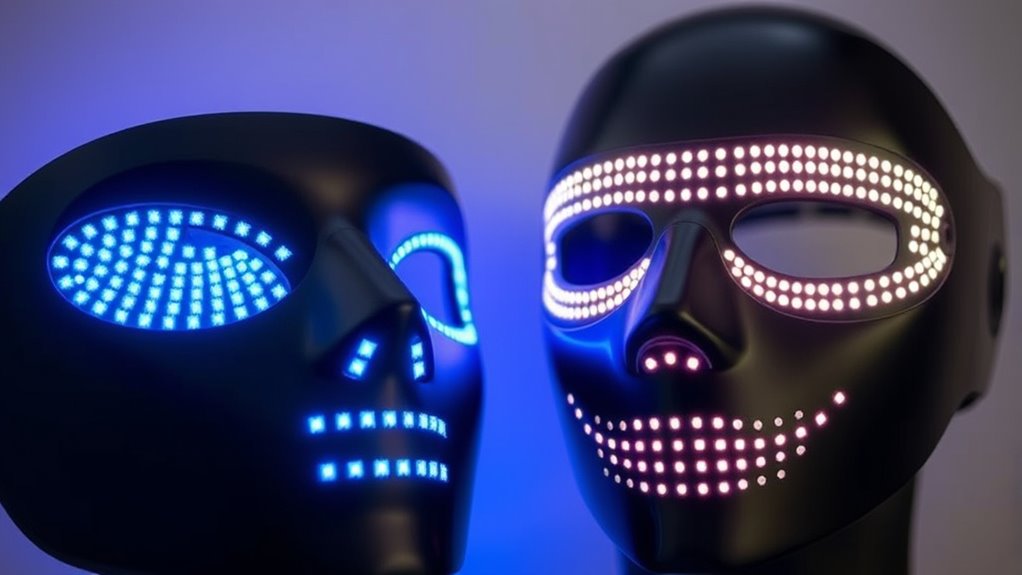
You need precise wavelength delivery to target specific skin cells effectively, which boosts your treatment results. Proper light intensity guarantees the energy penetrates deep enough to stimulate collagen and improve your skin. When these factors are off, your mask might only produce superficial or limited benefits. Additionally, grocery savings strategies can help you afford higher-quality devices if you’re looking to invest in more advanced options. Ensuring your device has reliable app integration and tracking features can also enhance your overall treatment experience and outcomes. Being aware of regional legal resources can help you find reputable providers and support if you encounter issues with your device.
Accurate Wavelength Delivery
Accurate wavelength delivery is crucial because it guarantees that the LED mask targets specific skin chromophores to produce ideal cellular responses. When wavelength accuracy is maintained within ±10 nm, your skin absorbs the light effectively, enhancing treatment results. Cheaper masks often lack proper LED calibration, leading to inconsistent wavelength delivery and reduced efficacy. Proper calibration ensures that the LEDs emit precise wavelengths and stable light intensity. Imagine:
- Precise beams hitting targeted skin layers
- Consistent energy delivery without fluctuations
- Penetration deep into skin tissues
- Effective stimulation of cell repair
- Reliable treatment sessions over time
Without accurate wavelength delivery, your skin misses out on the intended cellular responses, diminishing benefits. High-quality LED masks prioritize wavelength accuracy and stable light intensity, making treatments safer and more effective.
Proper Light Power Levels
Proper light power levels are essential because they determine whether the LED therapy delivers enough energy to activate skin cells effectively. Light intensity, measured in mW/cm², ensures the device provides the therapeutic irradiance needed for cellular response. If the light isn’t intense enough, treatment results will be minimal, especially since many budget masks have dimmer lights that fall short of these levels. Wavelength calibration is equally important; precise targeting within ±10 nm guarantees the light is absorbed by skin chromophores, maximizing benefits. Without proper calibration and sufficient power, devices produce inconsistent results and less visible skin improvement. A well-calibrated mask with verified wavelength and adequate light intensity delivers the correct energy dose, leading to more effective skin rejuvenation and better overall outcomes.
Deep Skin Penetration
Deep skin penetration relies heavily on both wavelength precision and light intensity, as these factors determine how effectively LED therapy reaches the deeper layers of your skin. If the wavelength isn’t targeted within the most effective 610-860 nm range, the light won’t penetrate deeply enough. Low light intensity further hampers deep penetration, leaving only superficial effects. Imagine:
- Narrow, precise wavelength beams focusing deep into the dermis
- Bright, high-powered lights ensuring energy reaches below surface layers
- Photons absorbed by collagen and mitochondria to stimulate cellular activity
- Broader, unfocused wavelengths dispersing energy at shallow levels
- Devices lacking proper calibration failing to activate deeper tissues
Without correct wavelength and sufficient light intensity, your treatment might only affect surface cells, reducing overall effectiveness. Deep penetration depends on both, making quality devices essential for real results.
Design, Comfort, and User Experience Differences
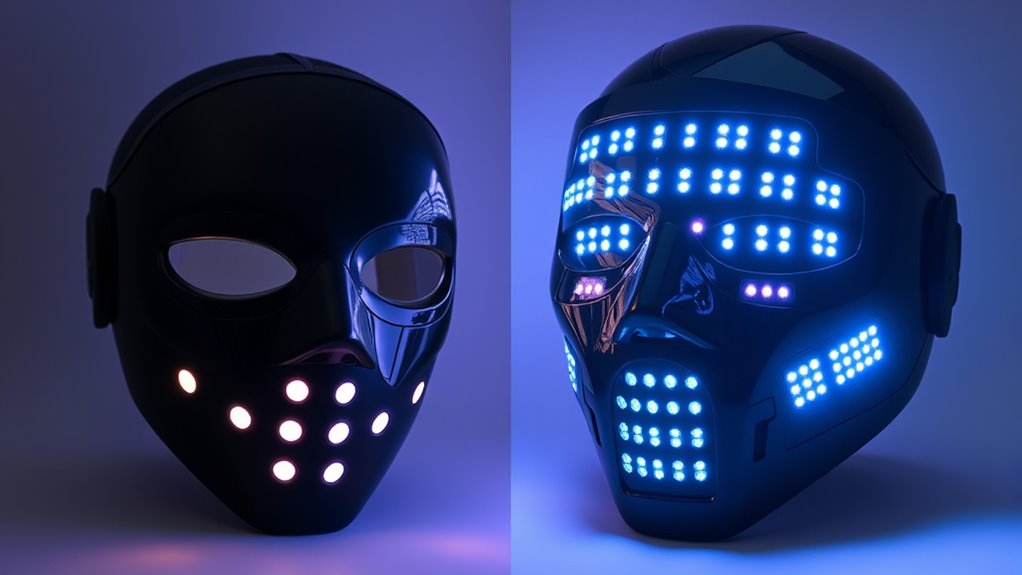
While cheaper LED masks may seem similar to their more expensive counterparts, their design and comfort often fall short. Many budget models feature rigid plastic shells that don’t conform to your face, causing discomfort during extended use. Their bulky design and misaligned eye cutouts make them awkward to wear and reduce treatment effectiveness. Higher-end masks use flexible silicone that molds to your face, offering a secure, comfortable fit. Cheaper devices usually lack adjustable straps or padding, leading to uneven light coverage and potential skin irritation. User reviews frequently mention discomfort, slipping, or irritation with low-cost masks. Overall, the design, comfort, and fit of affordable LED masks tend to be inferior, impacting both your experience and the device’s effectiveness during treatments.
Safety Certifications and Regulatory Standards
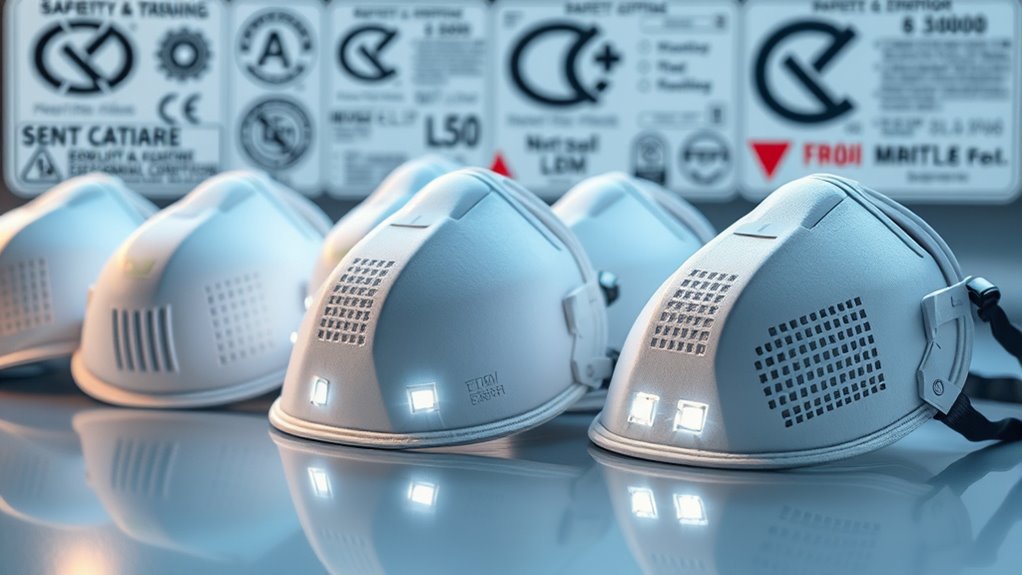
When choosing an LED mask, you should check its certification compliance levels to guarantee it meets safety standards. Regulatory safety standards require devices to pass strict tests for electrical safety, heat management, and skin compatibility. Without proper certifications, cheaper masks may pose risks like burns, irritation, or eye damage.
Certification Compliance Levels
Many high-end LED masks carry safety certifications like FDA clearance or dermatological approvals, giving you confidence they meet strict regulatory standards. Certification compliance guarantees the device adheres to safety standards such as IEC or UL, which low-cost masks often lack. Without these certifications, you risk using a device that may not be properly tested for electrical safety, skin compatibility, or eye protection. Imagine:
- Rigorous testing for overheating and electrical faults
- Verification of skin-safe materials
- Compliance with international safety standards
- Proper labeling and instructions
- Regulatory oversight to prevent malfunctions
Low-cost masks often skip these essential steps, increasing risks of malfunction, skin irritation, or long-term safety issues. Certification compliance levels directly influence the safety and reliability of your LED mask choice.
Regulatory Safety Standards
High-quality LED masks often carry safety certifications like FDA clearance or dermatological approvals, which verify they meet strict regulatory standards. These certifications ensure the device adheres to essential safety criteria, including electrical safety, skin compatibility, and eye safety. Certified masks undergo rigorous testing to confirm proper wiring, consistent wavelength emission, and the use of safe materials. In contrast, cheaper LED masks usually lack official safety certifications or regulatory approval, raising concerns about potential risks like overheating, electrical faults, or skin irritation. Without regulatory safety standards, these unverified devices may use low-quality wiring and plastics that can deteriorate or malfunction over time. Relying on certified masks offers peace of mind, knowing they meet recognized safety requirements and reduce the risk of adverse effects.
Real User Feedback on Efficacy and Comfort
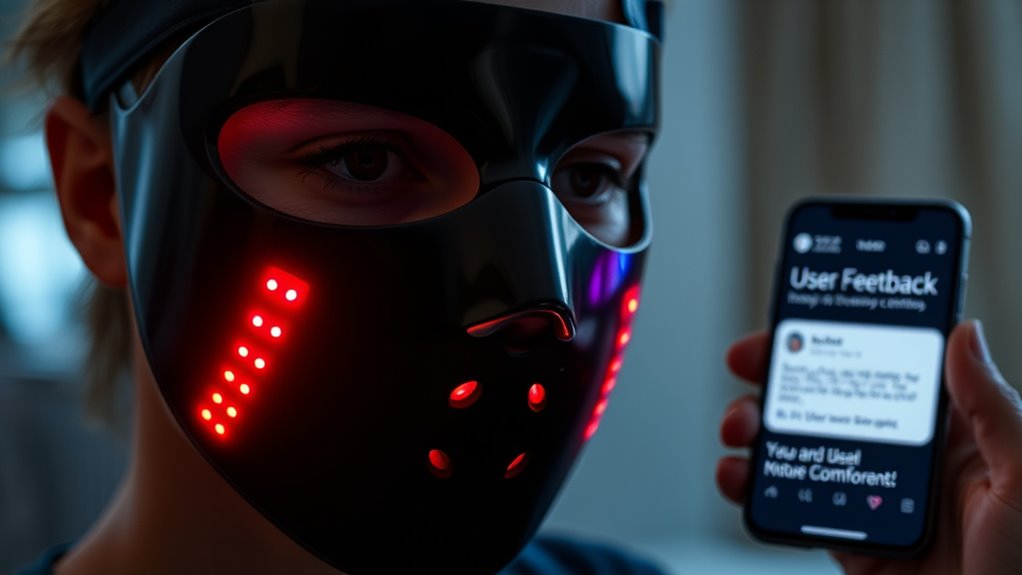
User reviews reveal that affordable LED masks often fall short in comfort and effectiveness. Many users find cheaper masks bulky, uncomfortable, and poorly fitting, making long sessions unpleasant. The lights tend to be dimmer, with inconsistent wavelengths that provide only mild skin improvement or negligible results. Safety concerns also arise, as budget masks often lack reliable eye protection during extended use. Imagine:
- Bulky designs pressing uncomfortably against your face
- Poor fit causing irritation and slipping
- Dim lights reducing treatment potency
- Irregular wavelengths limiting skin benefits
- Missing safety features raising concern
While inexpensive LED masks are accessible, user feedback shows they rarely match the comfort and efficacy of higher-end models costing $500 or more. If skin improvement is your goal, investing in better quality may be worth it.
Cost Analysis: When Does a Price Tag Reflect Value?
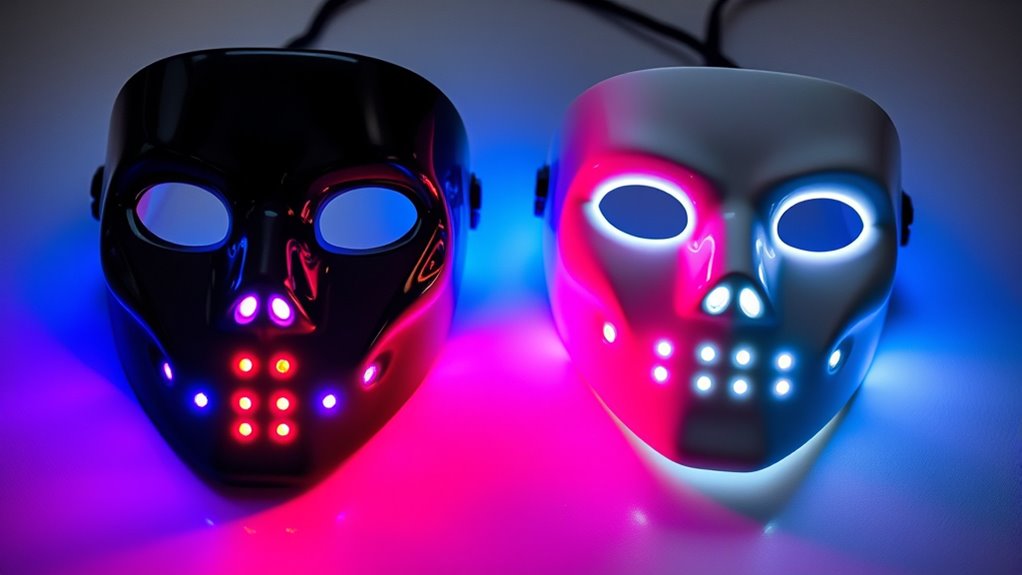
Determining whether a higher price tag for LED masks truly reflects better value requires examining what you’re getting for your money. Cost often correlates with the quality of materials—medical-grade silicone and durable construction—leading to increased safety and longevity. More expensive masks tend to be more effective because they deliver precise wavelengths and higher light intensity, boosting effectiveness. Cheaper options, usually under $50, often use low-quality materials and dim lights, reducing their skin benefits. The higher price also accounts for certifications, safety standards, and clinical validation, ensuring you get a reliable device. Ultimately, investing in a costlier mask can mean better durability, enhanced safety, and more consistent, measurable skincare results—making the price tag a reflection of true value.
Industry Expert Opinions on LED Mask Effectiveness

Industry experts warn that many budget LED masks rely on lower-quality components, which can substantially reduce their effectiveness. These cheaper masks often emit weaker light, limiting their ability to penetrate your skin and stimulate cellular responses. Clinicians stress that professional-grade masks undergo rigorous testing for accurate wavelengths, unlike low-cost versions that may lack proper calibration. Skin specialists caution that poor design, rigid plastics, and uneven light distribution compromise treatment results. You might imagine:
- Dull, less intense light targeting your skin
- Inconsistent light coverage across facial areas
- Wasted time and money on ineffective treatments
- Limited energy doses failing to activate skin cells
- Masks that break or malfunction easily
Ultimately, these lower-quality LED masks may not deliver the desired skin benefits, and their perceived affordability can be misleading.
How to Identify a Truly Effective LED Mask
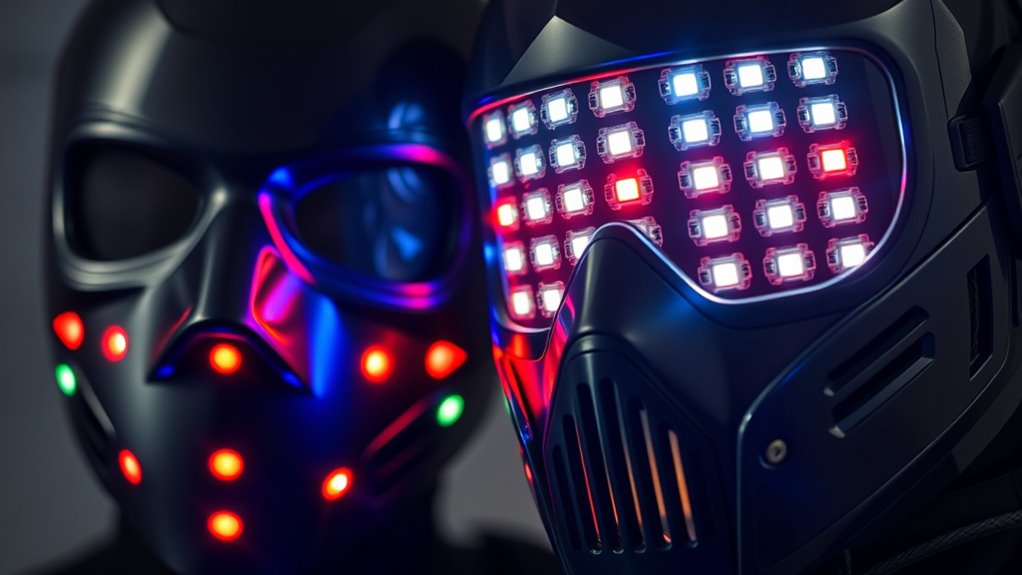
Choosing the right LED mask involves more than just comparing prices; you need to verify its quality and effectiveness. Start by examining the wavelengths it offers—effective masks deliver precise wavelengths within ±10 nm, ensuring ideal skin penetration and cellular response. Inaccurate or inconsistent wavelengths in cheaper models reduce treatment benefits. Look for masks tested to meet safety standards like FDA clearance or dermatological certification, which indicates reliability. Assess the device’s design—flexible materials, adjustable straps, and padded interiors promote even light distribution and comfort during use. Finally, review clinical results and reputable brand endorsements to confirm the mask’s proven efficacy. A truly effective LED mask combines precise wavelengths, proven safety, and documented clinical outcomes, ensuring you get results that justify your investment.
Practical Tips for Choosing the Right LED Device
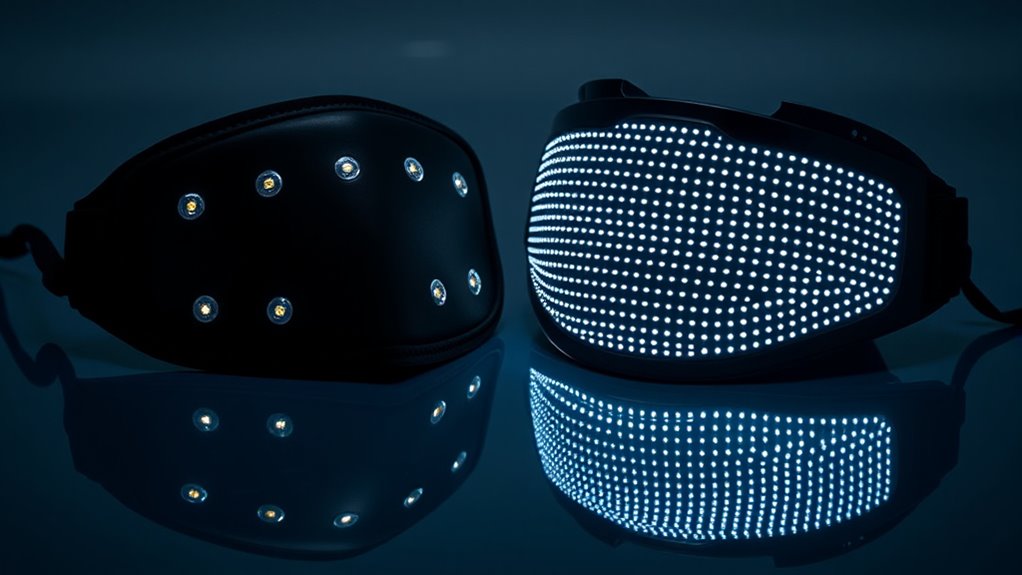
When selecting an LED device, focusing on certified wavelengths within the ideal range of 630-860nm is essential for effective skin penetration and visible results. To ensure you’re choosing the right LED masks, consider these practical tips:
- Visualize a device emitting precise light energy targeting deep skin layers.
- Opt for masks made from medical-grade silicone or flexible materials for comfort.
- Compare light source quality and wattage for consistent, targeted therapy.
- Look for safety certifications like FDA clearance or dermatological approval.
- Read user reviews and clinical trial data to gauge if budget models match professional-grade results.
These factors help you identify an LED mask that delivers effective skin penetration, comfort, and safety, regardless of price. Prioritize quality and certification for optimal, long-lasting results.
Frequently Asked Questions
Are Cheap LED Masks as Good as Expensive Ones?
You might wonder if cheap LED masks work as well as expensive ones. The study shows that lower-cost masks often deliver less accurate wavelengths and weaker light intensity, reducing their effectiveness. They tend to use lower-quality materials and calibration, which can cause malfunctions and less skin improvement. So, while cheaper masks are more affordable, they typically don’t provide the same results or durability as $500 models designed with medical-grade components.
What LED Mask Does Kim Kardashian Use?
Imagine your skincare routine as a garden; choosing the right tools helps it flourish. Kim Kardashian uses the Dr. Dennis Gross SpectraLite FaceWare Pro LED mask, a device costing around $435. This FDA-cleared mask uses red and blue LEDs to reduce wrinkles, boost collagen, and treat acne. Her glowing skin shows her trust in this high-quality, celebrity-endorsed device, making it a stellar choice for at-home LED therapy.
Are All LED Light Therapy Masks the Same?
You might think all LED light therapy masks are alike, but they’re not. Cheaper masks often use lower-quality LEDs with inaccurate wavelengths, meaning they don’t penetrate your skin as effectively. Higher-end masks are tested for precise light emission and safety, giving you better results. So, if you’re investing in skincare, don’t assume all masks are equal—quality, safety, and effectiveness vary widely.
Which Is the Most Effective LED Mask?
Imagine your skin as a garden waiting to bloom. The most effective LED mask acts like a gentle gardener, nurturing deep layers with precise, professional-grade light. You’ll want one with medical-grade silicone, multiple wavelengths, and adjustable settings—like a tailored suit for your face. These masks deliver deeper, consistent results, helping your skin flourish with improved tone, texture, and clarity, far beyond what basic models can achieve.
Conclusion
Remember, not all that glitters is gold—cheaper LED masks can pack a punch if they hit the right wavelengths and have solid safety standards. Think of it like hunting for treasure—you don’t need to spend a fortune to find something valuable. Do your research, compare features, and trust your skin’s needs over flashy price tags. With a little knowledge, you’ll strike gold in the world of affordable LED masks.
